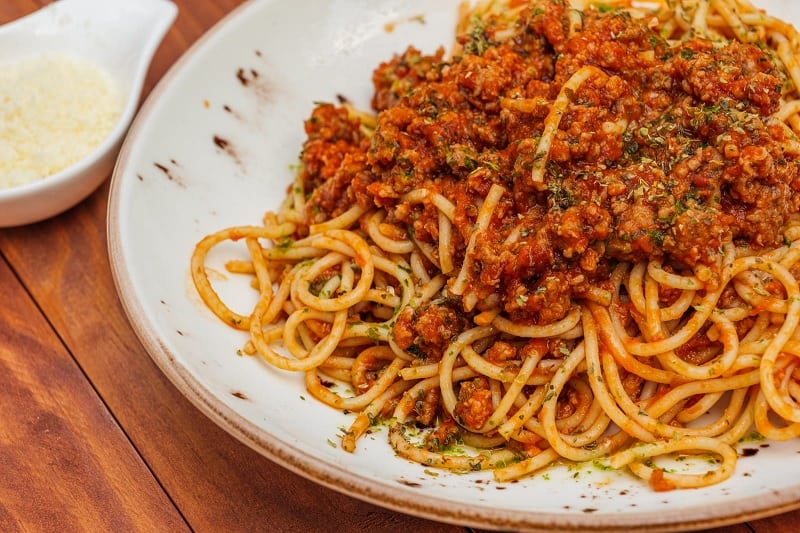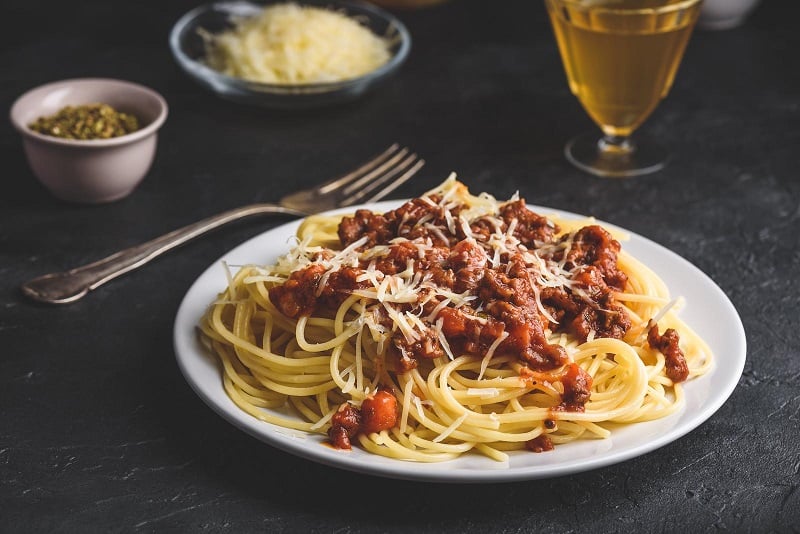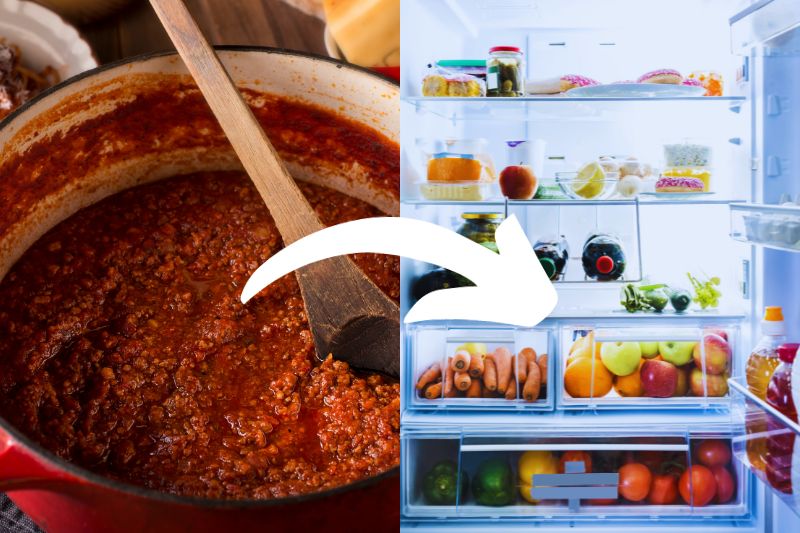Whether served over spaghetti or layered within a lasagna, bolognese is a hearty meat sauce with a knack for satisfying appetites and comforting taste buds.
It’s also one of the easiest meals to prepare ahead of time. But when you whip up a big batch to enjoy, one inevitable question arises: How does bolognese last in the fridge?
In this article, we explore the shelf life of bolognese sauce in the fridge. We also offer practical tips to ensure that your homemade or store-bought bolognese stays free from spoilage, and advice on reheating bolognese when you’re ready to enjoy a bowl of this classic Italian dish.
How Long Does Bolognese Sauce Last in the Fridge?
Bolognese can typically be stored in the fridge for three to four days. If there is no fresh meat in the sauce, your bolognese sauce might be safe to eat for up to five days.
Any leftovers you’ve had for longer than this should be thrown away as they have likely become contaminated by bacteria.
For your bolognese to last this long, you need to properly refrigerate it. Here is a step-by-step guide for refrigerating leftovers like bolognese based on advice from the Food Standards Agency:
- Cool completely: Remove your bolognese from the pan and place it in a storage container with the lid off. Let the bolognese sauce cool to room temperature before storing it in the fridge. Hot food raises the temperature inside the fridge and may promote bacterial growth.
- Airtight containers: Store the bolognese sauce in an airtight container or a resealable plastic bag. This helps prevent air and moisture from getting in, which can cause spoilage. The less air getting into the bolognese, the fresher it can stay for longer.
- Label and date: Clearly label the container with the date four or five days after you made the bolognese and treat this as a use-by date. This allows you to track its freshness easily—simply discard any remaining bolognese after this date.
- Store at the back: Keep your container of bolognese in the coldest part of the fridge, typically at the back. The temperature here is the most consistent, helping to limit the growth of harmful bacteria throughout the storage period.
If you don’t plan to use the bolognese sauce within four or five days, you can also consider freezing it. Bolognese sauce can be frozen for up to three months, significantly extending its shelf life.
To freeze, place it in an airtight container or a freezer-safe bag, remove as much air as possible, and label it with the date.
Thaw it in the refrigerator when you’re ready to use it again. You cannot refreeze mince once it’s cooked, so we suggest freezing individual portions of bolognese.
Alternatively, use the bolognese to make a lasagna, store it in the freezer, and cook the lasagna from frozen.

How Long Does Spaghetti Bolognese Last in the Fridge?
When you mix bolognese sauce with spaghetti or other pasta shapes, the storage guidelines remain similar to those for storing the sauce alone.
This is because cooked pasta has the same expiry period as bolognese sauce—it usually lasts between three and five days before starting to spoil.
The key to storing a mixture of bolognese sauce and cooked pasta safely is to use the same guidelines as above. To reiterate, you want to:
- Allow the spaghetti and bolognese to cool to room temperature before storage.
- Store the mixture in an air-tight container towards the back of your fridge.
- Label the container with a date five days from when you made the meal.
- Discard any remaining pasta and bolognese once this period has passed.
Keep in mind that pasta can absorb some of the moisture from the bolognese sauce, and its texture may change slightly when reheated. To refresh it, add a little extra sauce or a splash of water or broth when reheating.
However, a better option is to store the bolognese sauce and pasta separately in your fridge. This allows you to meal-prep ahead of time without compromising on taste.
Once the pasta is cooked, stir through a bit of olive oil to stop it from sticking together, then refrigerate for up to four days using the same guidelines as above.
How Can You Tell If Bolognese Is Off?
Did you forget to label your container of bolognese? Or have you forgotten to follow one of the guidelines and aren’t sure if it’s impacted the freshness of your meal?
Thankfully, you can determine if the bolognese sauce is off by using your senses of sight, smell, and taste.
Here are some common signs that bolognese sauce may have gone bad:
- Mould or unusual growth: If you see any mould or strange growth on the surface of the sauce, it’s a clear sign that it’s spoiled, and you should not consume it. Throw it away immediately and wash the container.
- Foul or sour odour: If the bolognese sauce emits an unpleasant odour, it’s likely gone bad. Foul smells are usually caused by bacteria that release chemicals as they break down the food. Fresh bolognese sauce should have a pleasant, savoury aroma.
- Unpleasant taste: If you don’t notice mould or an unusual smell, reheat the bolognese and taste a spoonful. If the sauce tastes off, it’s best to discard it. Fresh bolognese sauce should have a rich, meaty, and savoury taste.
- Separation or curdling: If the sauce has separated into different layers or has curdled, it may be a sign of spoilage or improper storage. It is safer to err on the side of caution and not consume the bolognese sauce.
Consuming spoiled food can lead to foodborne illness and food poisoning, especially with dishes containing meat. When in doubt, throw any leftovers that you have away and prepare a new batch.

How Can You Reheat Bolognese Safely?
Reheating your refrigerated bolognese leftovers is a straightforward process. It should be heated to at least 75°C to ensure it’s safe to eat, which you can do using a kitchen hob or microwave.
Your choice depends on your preference and the quantity of sauce you need to reheat.
The instructions for both options are shown below. However, these are intended as a rough guide.
The actual reheating time may vary depending on the quantity and thickness of the sauce, so keep an eye on it and use a food thermometer to ensure it reaches a safe temperature.
Reheating bolognese on the hob
- Place the desired amount of bolognese sauce in a saucepan or a frying pan.
- Heat the sauce over medium-low heat. Stir it occasionally to ensure even heating.
- If the sauce has thickened in the refrigerator, add a splash of water, broth, or milk.
- Continue to heat until the sauce is hot all the way through, typically for about 5 to 10 minutes.
- Once reheated to your satisfaction, serve over pasta or any other dish of your choice!
Reheating bolognese in the microwave
- Place the desired amount of bolognese sauce in a microwave-safe container.
- Cover the container with a microwave-safe lid or clingfilm, leaving a vent for steam to escape.
- Heat the sauce in the microwave using a medium power setting to prevent splattering.
- Heat the sauce in 1-minute intervals, stirring it between each to ensure it’s evenly heated.
- The total reheating time may vary depending on the amount of sauce and the power of your microwave, but it’s typically about 3 to 5 minutes.
- Once reheated, enjoy your bolognese with your favourite pasta or other dishes.
Tip: Be cautious when removing the container from the microwave, as it may be hot. Use oven gloves or a towel to handle it.

Hannah is a freelance content writer and self-proclaimed foodie. When Hannah isn’t sitting tapping at her laptop, you’ll probably find her in the kitchen. As an ex-chalet host, she’s used to cooking four-course meals for 10+ people and loves feeding friends and family whenever possible.





